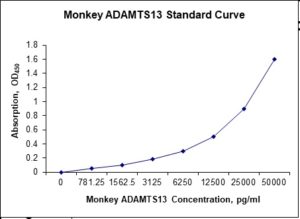Nori Monkey ADAMTS13 ELISA Kit
$461.00 – $832.00
This ELISA kit is for quantification of ADAMTS13 in monkey. This is a quick ELISA assay that reduces time to 50% compared to the conventional method, and the entire assay only takes 3 hours. This assay employs the quantitative sandwich enzyme immunoassay technique and uses biotin-streptavidin chemistry to improve the performance of the assays. An antibody specific for ADAMTS13 has been pre-coated onto a microplate. Standards and samples are pipetted into the wells and any ADAMTS13 present is bound by the immobilized antibody. After washing away any unbound substances, a detection antibody specific for ADAMTS13 is added to the wells. Following wash to remove any unbound antibody reagent, a detection reagent is added. After intensive wash a substrate solution is added to the wells and color develops in proportion to the amount of ADAMTS13 bound in the initial step. The color development is stopped, and the intensity of the color is measured.
Alternative names for ADAMTS13: ADAMTS13 (a disintegrin and metalloproteinase with a thrombospondin type 1 motif, member 13), von Willebrand factor-cleaving protease (VWFCP)
This product is for laboratory research use only, not for diagnostic and therapeutic purposes or any other purposes.
- Description
- How Elisa Works
- Product Citations
- Reviews (0)
Description
Nori Monkey ADAMTS13 ELISA Kit Summary
Alternative names for ADAMTS13: ADAMTS13 (a disintegrin and metalloproteinase with a thrombospondin type 1 motif, member 13), von Willebrand factor-cleaving protease (VWFCP)
Alternative names for monkey: Monkey
| Assay Type | Solid Phase Sandwich ELISA |
| Format | 96-well Microplate or 96-Well Strip Microplate |
| Method of Detection | Colorimetric |
| Number of Targets Detected | 1 |
| Target Antigen Accession Number | na |
| Assay Length | 3 hours |
| Quantitative/Semiquantitative | Quantitative |
| Sample Type | Plasma, Serum, Cell Culture, Urine, Cell/Tissue Lysates, Synovial Fluid, BAL, |
| Recommended Sample Dilution (Plasma/Serum) | No dilution for sample <ULOQ; sufficient dilution for samples >ULOQ |
| Sensitivity | 150 pg/mL |
| Detection Range | 0.78-50 ng/mL |
| Specificity | Monkey ADAMTS13 |
| Cross-Reactivity | < 0.5% cross-reactivity observed with available related molecules, < 50% cross-species reactivity observed with species tested. |
| Interference | No significant interference observed with available related molecules |
| Storage/Stability | 4 ºC for up to 6 months |
| Usage | For Laboratory Research Use Only. Not for diagnostic or therapeutic use. |
| Additional Notes | The kit allows for use in multiple experiments. |
Standard Curve
Kit Components
1. Pre-coated 96-well Microplate
2. Biotinylated Detection Antibody
3. Streptavidin-HRP Conjugate
4. Lyophilized Standards
5. TMB One-Step Substrate
6. Stop Solution
7. 20 x PBS
8. Assay Buffer
Other Materials Required but not Provided:
1. Microplate Reader capable of measuring absorption at 450 nm
2. Log-log graph paper or computer and software for ELISA data analysis
3. Precision pipettes (1-1000 µl)
4. Multi-channel pipettes (300 µl)
5. Distilled or deionized water
Protocol Outline
1. Prepare all reagents, samples and standards as instructed in the datasheet.
2. Add 100 µl of Standard or samples to each well and incubate 1 h at RT.
3. Add 100 µl of Working Detection Antibody to each well and incubate 1 h at RT.
4. Add 100 µl of Working Streptavidin-HRP to each well and incubate 20 min at RT.
5. Add 100 µl of Substrate to each well and incubate 5-30 min at RT.
6. Add 50 µl of Stop Solution to each well and read at 450 nm immediately.
Background:
ADAMTS13 (a disintegrin and metalloproteinase with a thrombospondin type 1 motif, member 13)—also known as von Willebrand factor-cleaving protease (VWFCP)—is a zinc-containing metalloprotease enzyme that cleaves von Willebrand factor (vWf), a large protein involved in blood clotting. It is secreted into the blood and degrades large vWf multimers, decreasing their activity. ADAMTS13 shares many properties with the 19 member ADAMTS family, all of which are characterised by a protease domain (the part that performs the protein hydrolysis), an adjacent disintegrin domain and one or more thrombospondin domains. ADAMTS13 in fact has eight thrombospondin domains. It has no hydrophobic transmembrane domain, and hence it is not anchored in the cell membrane. Deficiency of ADAMTS13 was originally discovered in Upshaw Schulman Syndrome, the recurring familial form of thrombotic thrombocytopenic purpura. Specific epitopes on ADAMTS13 surface have been shown to be the target of inhibitory antibodies. [1] Low levels of ADAMTS13 are also associated with an increased risk of arterial thrombosis,[2] including myocardial infarction[3] and cerebrovascular disease.[4] Since the link between aortic valve stenosis and angiodysplasia was proven to be due to high shear stress (Heyde’s syndrome), it has been accepted that increased exposure of vWf to ADAMTS13 due to various reasons would predispose to bleeding by causing increased degradation of vWf. This phenomenon is characterised by a form of von Willebrand disease (type 2a).
References
- Tsai HM (2003). Journal of the American Society of Nephrology. 14 (4): 1072–81.
- Sonneveld MA, et al. (2014). Blood Reviews. 28 (4): 167–78.
- Maino A, et al. (2015). Journal of Thrombosis and Haemostasis. 13 (8): 1396–404.
- Sonneveld MA, et al. (2015). Blood. 126 (25): 2739–46.
Be the first to review “Nori Monkey ADAMTS13 ELISA Kit”
You must be logged in to post a review.





























Reviews
There are no reviews yet.